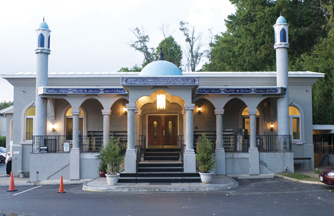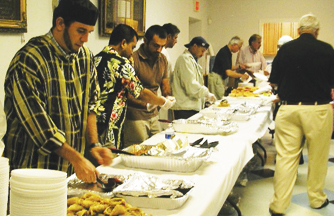 Imam Makhdoom Zia led off the Dec. 12, 2009 evening at the Mustafa Center in Annandale, Va. with a recitation of the Quran. Board members and others of significance from Mustafa Center’s past and present, including Ustadh Rashid Saljuki, the center’s inaugural president, and a current scholar-member of the board, spoke to the more than 400 people in the audience.
Imam Makhdoom Zia led off the Dec. 12, 2009 evening at the Mustafa Center in Annandale, Va. with a recitation of the Quran. Board members and others of significance from Mustafa Center’s past and present, including Ustadh Rashid Saljuki, the center’s inaugural president, and a current scholar-member of the board, spoke to the more than 400 people in the audience.
In Dari, Pashto and English, the lineup of speakers informed the audience of the history, struggles, and expansion of the Mustafa Center community.
This special occasion was the Mustafa Center’s ten-year anniversary, a feat which many of the center’s original founders, admittedly never thought possible. Even Mohammad Bashir, the president of the executive council, said he did not imagine the center would take off in this way.
The Need to Gather
In the 1980s, thousands of Afghan citizens migrated to the U.S. due to the Soviet invasion of Afghanistan. After arriving in the Annandale area in 1984, Bashir found there was no centralized masjid or center for prayers. He and his early neighbors traveled to farther locations to pray, such as the Islamic Center in Washington, D.C. and Dar Al-Hijrah, in Falls Church, Va. When this wasn’t an option, they tried other solutions.
“We rented a few places,” Bashir said. “We needed a place to make our prayers.”
In 1992, the Afghan-Muslim community became more structured and organized with the creation of the Afghan Academy, a non-profit organization meant to help and educate its members with citizenship, history, and Dari and Pashto, the two main Afghan languages.
One of the Academy’s first goals was to find a place to pray.
“We had to find some place that we could use to take care of our people,” said Nesar Zia, the Academy’s current president, and of no relation to the Imam. “We had to learn a new culture, new place, and a new language. A few people gathered together and said we had to do something for our society.”
The community’s prayer and gathering solution before the Academy was a rented apartment. With about ten people pitching in $25 each, the community had a small place to pray and hold small talks. With the organization of the Afghan Academy, the community began to rent bigger halls as the need for more prayer space grew.
Before the construction of the Mustafa Center, locals were praying at churches in Springfield and Alexandria, Va., making Taraweeh prayers at a Comfort Inn, and having Eid prayers in school gymnasiums and outdoor parks, said Tariq Arsalayee, the secretary of the Mustafa Center board. But while these solutions accommodated more people, residents wanted a permanent solution.
“It’s not just about prayers,” Arsalayee said. “It’s about [having] a base for the community, a place that the community turns to for all their needs and issues.”
Building
In 1995, the Afghan Academy took a step toward building this foundation by purchasing the land on which the Mustafa Center now stands. According to Bashir, the acre of land was home to an abandoned, boarded-up house. The neighbors, he said, had a lot of problems with the drugs and illegal activity taking place next door.
“When we bought the land, there were a lot of syringes, empty beer cans and beer bottles on the [premises],” Bashir said. “It was filthy.”
But after the Afghan Academy took over the land, Bashir and other volunteers began cleaning up.
In Sept. 1997, construction began. But building a mosque in the heart of Fairfax County was no easy task. Construction halted for six months while inspectors examined whether the dimensions of the rising Mustafa Center complied with obtained permits and zoning laws. And during the building process, early members of the center had to procure more funds. In Oct. 1997, the center borrowed $500,000 to supplement the donations made by the Muslim community, a loan that would have to be repaid.
The Mustafa Center was completed in 1999 at a total cost over $1 million. All debt left over from the construction was paid off in 2004.
During the center’s early days, residents of the quiet surrounding neighborhood expressed their concerns about the new establishment, worried about a potential increase in traffic, among other things. When Imam Zia first came to the Mustafa Center in 1999, about ten people came regularly for prayers.
Growing Involvement
Now, regular prayers sometimes attract hundreds of people, and more than 800 show up to the center’s two Jumah prayers, according to Arsalayee. To accommodate this larger audience, the center relies on a reciprocal parking relationship with the nearby Emmanuel Bible Church; masjid-goers can use the church parking lot on Fridays, and church-goers can use the Mustafa Center parking lot on Sundays. The Mustafa Center has a contract with a nearby shopping center to use their parking lot for overflow for Jumah prayer. The center also relies on dedicated volunteers, many who started coming in the last couple of years.
The center also relies on dedicated volunteers, many who started coming in the last couple of years.
Tariq Khan started volunteering five years ago. His nephew, Salman Mostafa, followed suit a year later. Both do background work at events, such as directing parking and serving food, and Khan even helps tutor kids at the center in his free time. Hasan Shah, a local grassroots activist, has been attending prayers at the Mustafa Center for five years. About a year ago, he began making it a priority to volunteer at the center.
“I find Mustafa Center to be a home of mine,” Shah said. “I can’t stop praising the work they do. I want to get more involved, if anything.”
Everyone’s Masjid
The increased attendance at Mustafa Center events means the masjid has evolved and become more diverse and multicultural, a fact not lost on the board and executive council. While many of the Afghan founders remain in leadership positions, they welcome the larger audience, which Bashir said came over the last four years.
“People come over here from different nationalities and cultures,” Bashir said. “For the unity of Muslims in this area, it is a big accomplishment.”
This transformation is evident in the Mustafa Center Youth Group, one of the most active in the area. The group, which Bashir said started four years ago, brings in monthly speakers to discuss various topics, organizes interfaith initiatives and volunteers in the community. Mostafa says Imam Zia’s ability to connect with the younger generation is a key factor in their consistent activity and participation.
“A lot of youth are very involved with the youth group and are very active with masjid activities,” Arsalayee said. “This is one of the good things. We see a lot of youth coming to the masjid.”
Imam Zia took it a step further.
“I believe the Mustafa Center Youth Group is the pride and future backbone of the Mustafa Center,” he said.
Omyra Ahmadzai, the youth group secretary, has been going to the Mustafa Center since its inception in 1999. She also spoke at the anniversary event.
“Over the years I went from being a student to a leader, and the Mustafa Center helped me get there,” she said. “I learned certain morals and values there that I would never learn anywhere else.”
While the masjid’s audience continues to grow, management has already considered expansion. The center’s attendees are feeling the space limitations, as the center hosts two Jumah prayers each Friday. While management has not looked up specific new locations for a bigger center, the idea is already being discussed, Nesar Zia said.
Until then, the constantly evolving and increasing audience at Mustafa Center continues to attend Imam Zia’s lectures, part-time Quran classes, interfaith programs and other events at the masjid.
“We did not recognize the potential back then, because our reach was not as strong,” Bashir said. “Now, we no longer specify the Mustafa Center as being an Afghan community mosque. It is everyone’s mosque.”
-------------------------------------------------------------
Look at this video made by the Mustafa Center Youth Group for the 10-year anniversary event on Dec. 12
{vimeo width="480"}8140624{/vimeo}









Comments powered by CComment